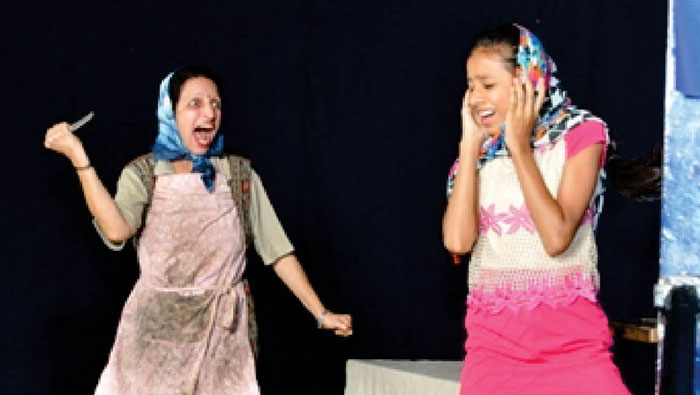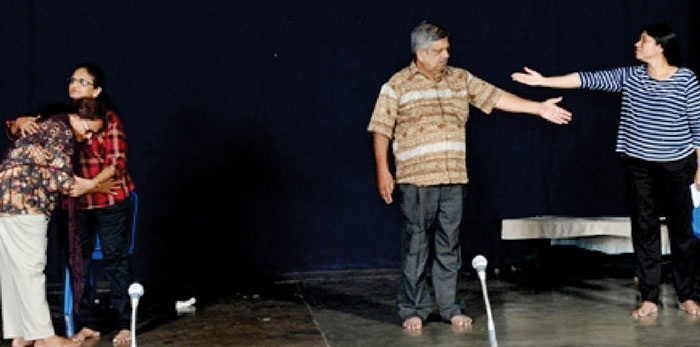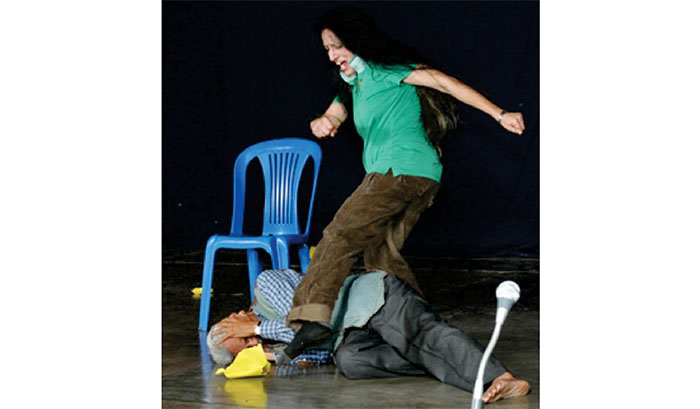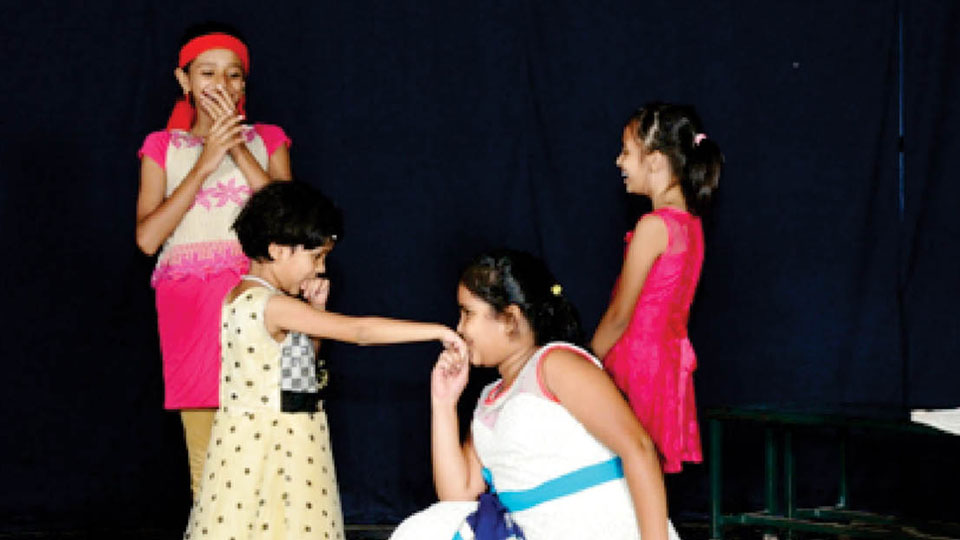Play ‘Stage Chemistry – Neuro-psychiatric Disorders on Stage’ dismantles borders and barriers
By Dr. R. Purnima, Director, Children’s Literary Club
The play ‘Stage Chemistry – Neuro-psychiatric Disorders on Stage’ was recently enacted by Children’s Literary Club in Mysuru and I was the scriptwriter, director and producer.
Let me tell you the story behind why I got involved myself in the play. Nearly two decades ago, I founded the Children’s Literary Club, a voluntary organisation, and I had conducted a programme “Talented Madmen.” Since then a desire to produce a full-fledged play on this subject was haunting me but I had kept it in abeyance. But this summer, I decided to get on to the stage.
I take this space to share my experience. The play, with eight short scenes, is interdisciplinary in nature. It is also an attempt to foster two cultures and reduce culture divide. In the play, the actors have not used any props, costumes and authentic make-up but they have played multiple roles. In the Opening Scene itself, it is made known that it is “Not Drama Therapy per se.” It is driven home that the main objective is to make the target group understand, accept and motivate them to get involved so that the world becomes a better place to live in for those affected. The Interlude connects the Opening Scene with the Mary Lamb Scene.

Mary Lamb scene: Mary Lamb (1764-1847), who was as talented and remarkable as her brother Charles Lamb, (a poet and an essayist) went violently insane and killed her own mother. After returning from a mental asylum she authored ‘Tales from Shakespeare,’ a great work along with her brother.
The Yellow Wallpaper scene: Select portions from Gilman’s short story “The Yellow Wallpaper,” a powerful critique of the medical profession and one of the founding texts of American feminism, was next taken up for staging. Gilman’s (American writer, 1860-1935) classic tale deals with post-natal/ post-partum depression. After making Gilman herself talk about her life of entrapment and eventual escape, select portions from the story were enacted.
Sylvia Plath Scene: After depicting the marital discord between Sylvia Plath and Ted Hughes, and Sylvia’s distraught state of mind, her preparation for the final act of suicide and her neighbours/ friends/ and admirers’ responses to her suicide and greatness as a writer, the Scene ends with a Voice off the Stage, which recalls what has just been staged. Scenes 2 and 3 demonstrated many aspects of the lives and legacies of Charlotte Perkins Gilman and Sylvia Plath. Though the two were plagued by mental illness, they wished to be more than just a wife and a mother and aspired to be women of great consequences.

Muscular Atrophy scene: Audience at the outset of Scene 5 were apprised of what Spinal muscular atrophy is. It is made known that it is “a genetic disease affecting part of nervous system that controls voluntary muscle movement.” The problem encountered by a victim is made known by a child artiste.
Gullian-Barre Syndrome (GBS) scene: Scene begins with participant/ doctor making notes after reading the memoirs titled ‘Sickened: The Memoir of a Munchausen by Proxy Childhood’ by Julie Gregory and ‘Wide Awake and Dreaming’ by Julie Flygare, a Narcoleptic. Finally, S.K. Lakshminarayan’s ‘Remembrance of Things Past: The Memoir by a Gullian-Barre Syndrome Sufferer and Survivor’ is taken up for staging. The survivor of this syndrome explains what GBS means. “It is a rare disorder of the peripheral nervous system.” The role of GBS sufferer was played by Lakshminarayan (Babu), the sufferer and survivor himself.
Alzheimer’s scene: The audience is told by a Voice off the stage that “like all types of dementia, Alzheimer’s is a neurodegenerative disease.” The episode presented is based on a case study and Interview. The anxiety and agony of the spouse of the one with this problem was the crux of this scene.

The Quiz scene: The play within a play initiative ended with a quiz programme. Questions were set on topics by intertwining neuroscience and literature. The scene comprised audio/ visuals through play-acting. Disorders covered in the quiz were not covered in the scenes enacted. It ranged from Greek/Roman times to the literature of the 20th Century. Besides acting out lines from Don Quixote (to illustrate ‘Delusion of Grandeur’) and ‘Somnambulism’ (Sleep-Walking Scene from Macbeth), questions covered several other disorders.
Writers and texts covered were Agatha Christi, Wilfred Owen, Tender is the Night, The Catcher in the Rye, Mrs. Dalloway, Lolita, Wuthering Heights, Macbeth. Topics even touched The Greek Outdoor Amphitheatre with amazing acoustics, plays like Heracles by Euripides, and The Mad Hercules, by Seneca the Younger. Special questions were set to participant-kids, touching on insanity, etc.
Another noteworthy feature of this production was that out of the 14 who had acted, it was their first stage experience for 9. Acting in English Drama was the first experience for 11. All of them played their roles with unfaltering assurance.
An eye-catching feature is the way in which connections were established between short scenes. It was either through what happens in the Interlude, or a Voice off the Stage, connecting one another. A brief introduction to the disorder to be presented or to the character/ or writer suffering from something, made the audience comprehend the issue better.
Children were encouraged to read a lot. They were motivated to learn the beauty, value and range of several disciplines through this play. Participation made the kids familiar with vocabulary/terms used in theatre arts like ‘miming’/ ‘business’/ ‘blocking’/ ‘freeze’/ ‘sub-text’/ ‘property-in-charge/ ‘improvisation’, besides ‘navarasas’. The zeal and sincerity of these children was commendable. Two children hailing from economically lower strata of society also acted. The bare-minimum stage devices used won appreciation from the audience. Yet another eye catching feature was that the oldest actor was 80+ and the youngest was only six.
Well-known neurosurgeon and Hindustani Vocalist Dr. M.S. Bhaskar opined, “It was a feast to watch the whole episode.”








Recent Comments